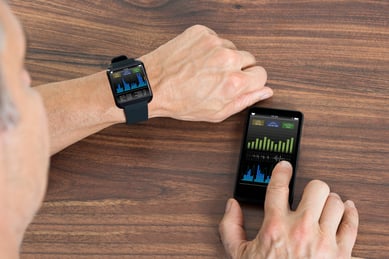Fitness trackers are all the buzz these days, but do you know what to look for when choosing one? With so many sizes, colors, capabilities and prices, which one should you choose? Or should you even invest in one? Let me offer some considerations when or if you do choose to purchase one.
If you’re like me, you contemplated making this purchase and for good reason! Wearable fitness tracking devices can vary in prices, from $50.00 all the way up to $1,095.00! With that hefty price tag, comes many things to consider. Do you think you’ll use it, what exactly are you trying to track or monitor, and do you need water resistant or waterproof? Let’s break down the capabilities of these devices and what you should ask yourself as you research the different options.
[Related Post: Why Wearable Fitness Trackers Aren't Your Wellness Program]
You must first ask yourself if you think you’ll find activity-tracking beneficial. You certainly don’t want to buy it only for it to sit on the dresser collecting dust. If you do think you want to purchase one, you have five things you’ll want to consider; style, display, compatibility, battery life and water proof.
Fitness trackers range from the super simple, to featuring all the bells and whistles. If you want to know how many steps you take a day, look for an all-day tracker. However, if you want more details on those steps (e.g. speed, pace, and stride), you may want to investigate a training tracker. Training trackers can provide data that’s specifically tailored to a certain exercise (i.e. marathon runners). All day trackers measure your total steps taken, stairs you’ve climbed, duration of exercise, active minutes and sleep time. Training trackers do everything an all-day tracker does PLUS the following: heart rate, breathing patterns, miles traveled, speed, pace, and route information. Some may also be able to control music, make and receive calls, text messaging and emails. Now let’s talk more in depth about the five options I mentioned above.
![]()
Style - Many trackers can be worn on the wrist, but there are some that can be worn as pendants or clipped to your clothing. Manufacturers are also paying more attention to design details; think color, shape, and material. Make sure you choose one you’ll feel comfortable wearing all day.
Display - The advanced trackers display a slew of data on the screen. Others (i.e. pendant trackers) show limited data and display information via an LED light, or will only show up on an app. Think about how you want to see your data. Do you want to see it immediately, or are you okay with looking it up on an app when near your phone?
Compatibility - Make sure your cell phone or computer is compatible before you buy a tracker. There’s nothing worse than spending money, only to realize the device isn’t user friendly with your current phone or computer. Most devices on the market will work with Apple’s iOS and Android systems. However, few work devices work with Windows.
Battery Life - Depending on which device you choose, will depend on the length of battery life. A tracker with more bells and whistles will require more frequent charges than a simple band tracker. You also want to pay attention to rechargeable versus non-rechargeable. Some run on batteries like cameras and calculators, others come with charging devices.
Water - Trackers are either water-resistant or waterproof. Keep in mind, water resistant only means that the tracker can be splashed with water, not submerged. This means they can withstand a decent amount of sweating, but certainly not a dip in the pool.
I hope that this information will help you narrow down which type of tracker to purchase. Or, maybe I talked you out of purchasing one altogether. Either way, remember that a tracker is a lot like a gym membership - you must use it for it to work!


 Considering how long it can take to make a global shift in corporate America, the rise of wearable fitness trackers in wellness has been meteoric. A recent study reports an anticipated
Considering how long it can take to make a global shift in corporate America, the rise of wearable fitness trackers in wellness has been meteoric. A recent study reports an anticipated 